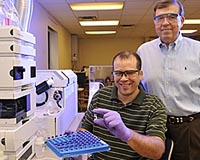| . |  |
. |
Akouedo, Ivory Coast (AFP) Sept 19, 2009 Three years after a ship dumped toxic waste in Ivory Coast, residents of a village off the main city of Abidjan are still traumatised by untimely deaths they say are linked to poisoning. "We are living on borrowed time," said Bienvenue Danho, who is in charge of waste disposal at Akouedo, northeast of Abidjan, about the 2006 spill that caused 15 deaths and countless infections, according to a UN expert. "There are unexplained deaths even today," said Blaise Adja, the head of a local youth association. Over 100,000 people have sought medical help for problems including vomiting, diarrhoea and breathing difficulties. "Three years after the scandal, we are only witnessing the short-term effects," Adja, a high school teacher, said, evoking the case of a 40-year-old man who had worked to clear up the waste and died this week of a throat tumour. "Who will be the next one?" added Jean Fortune Tope, echoing a common worry. In August 2006, the Probo Koala ship, chartered by Dutch firm Trafigura, dumped deadly caustic soda and petroleum residues on city waste tips in Abidjan -- having first attempted to offload the cargo in Amsterdam. Trafigura, an oil trading firm, has already paid a one hundred billion CFA francs (152 million euros) in damages to the victims of the toxic poisoning in an out-of-court deal with the Ivory Coast government which exempts it from legal proceedings in the west African nation. It also cleaned up the waste and agreed to build a waste incinerator to tackle Abidjan's pollution problem. However, a UN expert this week said there was "strong" evidence linking at least 15 deaths and several hospitalisations to the incident. "Indeed, there is a strong basis to conclude that the deaths and illnesses were directly and indirectly linked to the dumping waste," said Okechukwu Ibeanu. "Residents in areas close to the dumping sites were directly exposed to the waste through skin contact and breathing of the volatile substances," he said. A lawyer for victims taking legal action in Britain, where Trafigura has offices, had said on Wednesday that the company had offered a global settlement which "is likely to be acceptable to most, if not all, of the claimants." The company will pay thousands of people who suffered short-term illnesses including vomiting, diarrhoea and breathing difficulties. The compensation will run to millions of pounds (dollars), reports said. The Dutch multinational firm had reiterated that it was not responsible for deaths or serious injuries from the dumping, and has not admitted liability. Court proceedings are ongoing in the Netherlands, with hearings scheduled for 2010. Environmental group Greenpeace has asked a Dutch judge to order prosecutors to broaden the probe beyond the Netherlands. A decision should be taken within two months. The possibility of a new compensation deal is however dismissed by most in Akouedo, with locals saying victims had only received a fourth of the compensation Trafigura paid the government. Many allege that their names do not figure in the list of victims. "It was a bargain," snorted Jean Fortune Tope. "The state rushed through this urgent matter without thinking of the future," added David Gouedan. Locals complain that they have not seen any of 500 million CFA francs allocated by the government for social projects in the village, where there is a giant dumping ground spanning scores of acres. Meanwhile, a stench hangs over the area even now and "becomes stronger during the monsoon," complained Agnes Koutouan, casting a worried glance at a gutter filled with slimy green water and emanating a nauseous odour. Share This Article With Planet Earth
Related Links Our Polluted World and Cleaning It Up
 New X-ray Technique Illuminates Reactivity Of Environmental Contaminants
New X-ray Technique Illuminates Reactivity Of Environmental ContaminantsNewark DE (SPX) Sep 16, 2009 A chemical reaction can occur in the blink of an eye. Thanks to a new analytical method employed by researchers at the University of Delaware, scientists can now pinpoint, at the millisecond level, what happens as harmful environmental contaminants such as arsenic begin to react with soil and water under various conditions. Quantifying the initial rates of such reactions is essential for ... read more |
|
| The content herein, unless otherwise known to be public domain, are Copyright 1995-2009 - SpaceDaily. AFP and UPI Wire Stories are copyright Agence France-Presse and United Press International. ESA Portal Reports are copyright European Space Agency. All NASA sourced material is public domain. Additional copyrights may apply in whole or part to other bona fide parties. Advertising does not imply endorsement,agreement or approval of any opinions, statements or information provided by SpaceDaily on any Web page published or hosted by SpaceDaily. Privacy Statement |